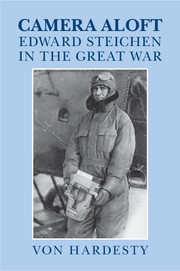Refine search
Actions for selected content:
12661 results in History of science

Camera Aloft
- Edward Steichen in the Great War
-
- Published online:
- 05 December 2015
- Print publication:
- 02 December 2015
Appendix: Life at the cutting edge: The photo sections
-
- Book:
- Camera Aloft
- Published online:
- 05 December 2015
- Print publication:
- 02 December 2015, pp 138-150
-
- Chapter
- Export citation
Frontispiece
-
- Book:
- Camera Aloft
- Published online:
- 05 December 2015
- Print publication:
- 02 December 2015, pp xvii-xviii
-
- Chapter
- Export citation
Contents
-
- Book:
- Camera Aloft
- Published online:
- 05 December 2015
- Print publication:
- 02 December 2015, pp vii-viii
-
- Chapter
- Export citation
Copyright page
-
- Book:
- Camera Aloft
- Published online:
- 05 December 2015
- Print publication:
- 02 December 2015, pp iv-iv
-
- Chapter
- Export citation
6 - Over the front
-
- Book:
- Camera Aloft
- Published online:
- 05 December 2015
- Print publication:
- 02 December 2015, pp 109-137
-
- Chapter
- Export citation
2 - A new life in the military
-
- Book:
- Camera Aloft
- Published online:
- 05 December 2015
- Print publication:
- 02 December 2015, pp 10-34
-
- Chapter
- Export citation
1 - War and exile
-
- Book:
- Camera Aloft
- Published online:
- 05 December 2015
- Print publication:
- 02 December 2015, pp 1-9
-
- Chapter
- Export citation
Acknowledgements
-
- Book:
- Camera Aloft
- Published online:
- 05 December 2015
- Print publication:
- 02 December 2015, pp ix-xii
-
- Chapter
- Export citation
History Photo Section No. 3, Air Service, 1918
- from Appendix: Life at the cutting edge: The photo sections
-
- Book:
- Camera Aloft
- Published online:
- 05 December 2015
- Print publication:
- 02 December 2015, pp 174-178
-
- Chapter
- Export citation
Foreword
-
- Book:
- Camera Aloft
- Published online:
- 05 December 2015
- Print publication:
- 02 December 2015, pp xiii-xvi
-
- Chapter
- Export citation
Dedication
-
- Book:
- Camera Aloft
- Published online:
- 05 December 2015
- Print publication:
- 02 December 2015, pp v-vi
-
- Chapter
- Export citation
Index
-
- Book:
- Camera Aloft
- Published online:
- 05 December 2015
- Print publication:
- 02 December 2015, pp 189-193
-
- Chapter
- Export citation
Notes on Research
-
- Book:
- Camera Aloft
- Published online:
- 05 December 2015
- Print publication:
- 02 December 2015, pp 185-188
-
- Chapter
- Export citation
7 - War and photography
-
- Book:
- Camera Aloft
- Published online:
- 05 December 2015
- Print publication:
- 02 December 2015, pp 138-150
-
- Chapter
- Export citation
History of Photo Section No. 1, Air Service, 1918
- from Appendix: Life at the cutting edge: The photo sections
-
- Book:
- Camera Aloft
- Published online:
- 05 December 2015
- Print publication:
- 02 December 2015, pp 153-163
-
- Chapter
- Export citation
Camera Aloft: A Gallery of Images
-
- Book:
- Camera Aloft
- Published online:
- 05 December 2015
- Print publication:
- 02 December 2015, pp 194-194
-
- Chapter
- Export citation
4 - The world of air observation
-
- Book:
- Camera Aloft
- Published online:
- 05 December 2015
- Print publication:
- 02 December 2015, pp 60-84
-
- Chapter
- Export citation
History of Photographic Section No. 4, Air Service, U.S.A. 1918
- from Appendix: Life at the cutting edge: The photo sections
-
- Book:
- Camera Aloft
- Published online:
- 05 December 2015
- Print publication:
- 02 December 2015, pp 179-184
-
- Chapter
- Export citation
3 - Over there
-
- Book:
- Camera Aloft
- Published online:
- 05 December 2015
- Print publication:
- 02 December 2015, pp 35-59
-
- Chapter
- Export citation
